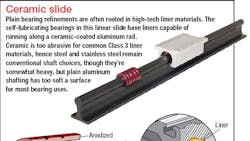MSD 101: Mechanical PT
Plain linear bearings
Ball and roller bearings have traditionally offered the acceleration, speed, and accuracy necessary for linear machinery. But plain bearing materials and construction have advanced over the years, and many applications are found where these bearings are suitable, even mandatory.
According to the Plain Bearings Standards Association (PBSA), plain bearings fall into three categories. Class 1 bearings require external lubrication to function properly. Some examples are nylon, bronze, and babbitt bearings. Class 2 bearings have some form of lubrication impregnated in the bearing wall during the manufacturing process. The lubricant is eventually used up and may sometimes be reinstalled, but often the bearing is simply replaced. Class 2 bearings include bronze, graphite-plugged bronze, oil filled nylon, oil filled plastics, and powdered metal.
Class 3 plain bearings, the most modern, are selflubricating, taking advantage of Teflon and newer plastics. Although early versions were poor, refinements in the way of metal backings (steel, stainless steel, aluminum, and the like) and better self-lubricating liner materials have made a difference. The improved configuration expanded both the linear and rotary capabilities of plane bearings, instilling high load capacity, extreme temperature endurance, vibration damping, and some shock absorption. Today’s plain bearings have a highly predictable wear life and thus their tendency to catastrophically fail is extremely low – fairly infrequent scheduled replacements tend to satisfy such concerns. (A bit of trivia: although “plain” is the familiar textbook spelling, some manufacturers prefer “plane” and what it connotes.)
Questions & Answers
Q. Are plain bearings better suited for linear rather than rotary applications?
A. They do work best in linear applications because sliding contact generates heat that is easier to disperse when the bearing translates down the shaft. In rotary applications heat is confined, since the journal doesn’t change.
Q. Do plain linear bearings need seals?
A. Generally they do not. They are reasonably insensitive to particulates, since the load is well distributed across sliding contact surfaces; and Class 3 bearings require no lubrication and are fairly corrosion-resistant. There are, however, severe cases where seals are necessary, such as excessively dusty and dirty environments.
Q. How do plain linear bearings fail?
A. Usually, wear is predictable, life expectancy is accurate, and complete failure is avoidable. Frictional wear will eventually lead to a sloppy fit between the shaft and the bearing sleeve. A more abrupt form of failure can occur from binding, typically caused by misalignment during assembly of the linear motion system, or by extreme contamination in conditions where a seal should have been installed. Binding can stop a system in its tracks, and is nearly always preventable with the proper setup.
